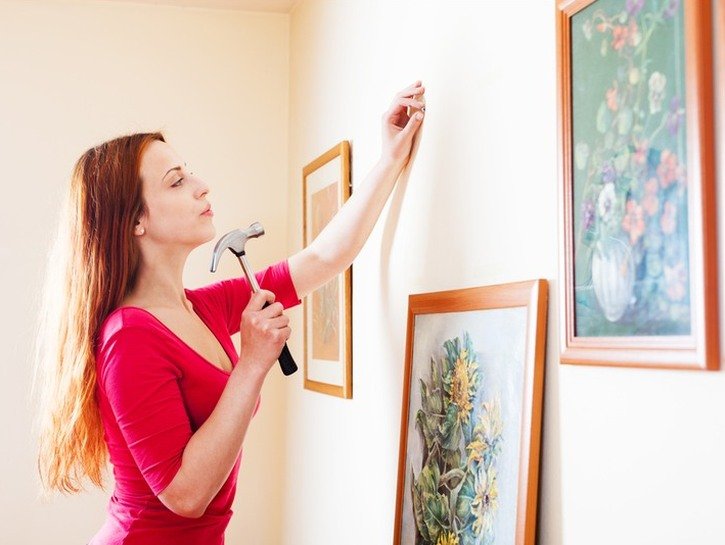You’ve bought the perfect painting to brighten up an otherwise drab and colorless room. You’re ready to transform the space! There’s just one problem… you’re not sure how to hang your art. Should it go by the window? Above the fireplace? How high up is too high? What kind of nail are you supposed to use, anyway?
Don’t worry, we’ll have that room looking energized and new in no time.
How To Hang Smaller Paintings
For a painting that’s less than 5 pounds, a regular 4D or 6D finishing nail will secure it, even in drywall. The nail you use should be about 1.5 inches. Anything under 1 inch will likely be too short and anything over 2 inches will be too long. (For walls made of brick or plaster, use a screw instead.)
Use a hammer to drive the nail into the wall at a 45-degree downward angle. Always hit the nail in so that the head is angled up towards the ceiling, instead of hammering the nail in straight. This anchors the nail into the wall more securely and allows the weight of the painting to work with the nail, instead of against it. Don’t drive it in too far! You want about 1/2 an inch of nail left sticking out of the wall to secure your painting onto.
Attach a D-ring to the center of the back of the painting. Measure across the painting and mark the middle of the top, and attach the ring precisely here so the painting will hang straight.
Hang up your painting so that the D-ring lines up with the nail. Step back at least 5 feet from the painting to see if it’s hanging symmetrically.

Irina Magrelo/Shutterstock
How To Hang Heavier Paintings
Attach a picture-hanging wire to the back of the frame, as well as two D-rings at each corner of back. After you’ve secured the D-rings, string the wire through the hooks. Using a wire will distribute the weight of the painting across the back and the two rings, rather than relying on a single point where all the weight is concentrated.
Depending on the size and weight of the painting, pick a sturdy, curved hanger that will brace against the inside of the wall, or use multiple 10D or 12D nails. For plaster walls, consider drilling a hole and using a screw with a plastic sleeve that expands as it’s screwed into the wall.
Gently align the wire with the nails or hangers in the wall. Always hang heavy paintings slowly to ensure the hangers are set in place. Step back and examine whether the painting hangs straight, and adjust accordingly.

Iakov Filimonov/Shutterstock
Where To Place Your Painting
For smaller paintings (between 1 and 3 square feet), don’t hang the art on an otherwise empty wall. This will just draw attention to the space around the painting and make the painting look smaller. Find a more narrow section of wall and hang the art at eye level, generally around 60 inches from the ground.
For larger paintings, it can be harder to tell where a comfortable eye level may be. A good rule of thumb is to start with a universal base height of 57 inches from the ground. Then measure the length of the painting, and divide that height by 2, adding that number of inches to 57 to find where the middle of your painting should be based. Depending on the size and shape of the art, it may also take some eyeballing to determine exactly what feels right for your home.
When it comes to larger paintings especially, it’s a good idea to have an understanding of the walls of the room. Check for electricity lines and water pipes – especially if you live in an older home – to prevent yourself from accidentally screwing a hole into an unsuspecting water pipe.
Be cautious about where you choose to position paintings, as there are some areas that may actually damage your art if you’re not careful. While hanging an impressive painting above the fireplace is a classic decorative move, a painting above a working fireplace can be damaged by heat over time and the canvas itself may begin to melt! Similarly, paintings can be damaged if positioned above a radiator, or in the path of direct sunlight. Light is particularly harmful to drawings and watercolors, so never hang these near a window.

Photographee.eu/Shutterstock
Tips and Tricks
- Use a tape measure and a level to ensure your paintings hang centered. Our eyes can play tricks on us and make a frame look symmetrical, even when it’s not.
- Hang small paintings together or with an assortment of larger paintings to create a sense of balance along a wall.
- For very flat pieces of art of any size, keep the work from hanging forward or swaying when people walk past it by securing it with multiple fastenings on both sides.
- If you are hanging multiple paintings and want to see how they will look together, arrange them on the floor so you can visualize what the finished wall will look like
